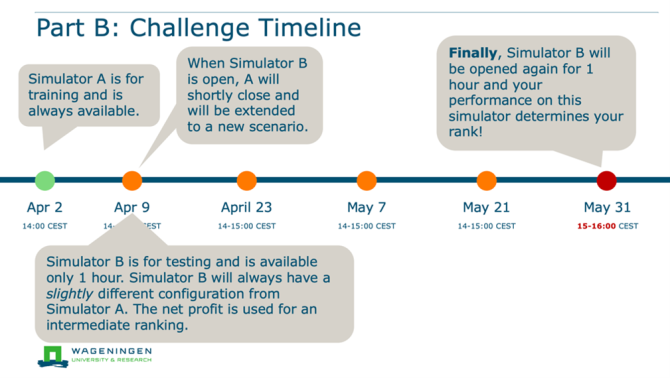
News
Fourth Autonomous Greenhouse Challenge started
The fourth Wageningen University & Research's Autonomous Greenhouse Challenge has started. Using artificial intelligence and machine learning, 23 teams from around the world will take on the challenge of growing dwarf tomatoes fully autonomously. Until 31 May, the competition takes place in a virtual environment. The five best teams will be selected for the next phase. In autumn, they will be given their own greenhouse compartment at WUR in Bleiswijk to grow real dwarf tomatoes as sustainably and autonomously as possible.
AI supports human decisions
Today's greenhouses already feature a high level of automation for crop production. Climate control and irrigation are generally automated. However, decisions such as the required temperature in the greenhouse, planting distances and harvesting times are still made by growers themselves. Based on their knowledge and experience, growers strive to optimise yields with efficient use of resources. This process is subjective and labour-intensive, requiring considerable experience. Artificial intelligence and machine learning can play a role in improving decision-making processes and production efficiency. The Autonomous Greenhouse Challenge aims to stimulate the development of new, fully automated techniques in greenhouse farming. In this Challenge, dwarf tomato cultivation was chosen because autonomous cultivation of tomatoes could potentially replace traditional high-wire tomato cultivation in the future. This method of cultivation is currently very labour-intensive.
Building algorithms
The first phase of this Autonomous Greenhouse Challenge will take place from 2 April to 31 May as an Online Challenge. During this phase, participating teams will develop algorithms based on training images of dwarf tomato plants. These algorithms are designed to analyse various plant characteristics, including plant length, leaf area, number of fruits and maturity.
Teams receive a training set with annotated images, including manually measured data (ground truth) to refine their algorithm. They are then given the opportunity to validate their algorithm several times before receiving an unknown test set of images for the final assessment of the developed algorithms. In the final evaluation, teams are ranked based on the difference between their predicted data and manual measurements.

Teams are subsequently challenged to use machine learning and AI to develop algorithms to independently control a virtual greenhouse and crop, including ventilation, heating, screens and lighting. The algorithms must ensure that a virtual crop of dwarf tomatoes grows well while using as little energy and other resources as possible. A successful crop, with enough ripe fruit and high dry matter, yields profits. But using energy, CO2 and greenhouse space involves costs. Ultimately, the teams are ranked based on their net profit.

Hackathon event for participating teams
All participating teams will be invited to a Hackathon event on 6/7 June at WUR in Bleiswijk. During this event, the points for the two parts of the Online Challenge will be announced. Teams can earn extra points by performing an additional task and by giving a presentation on their approach in front of an international jury. The five teams with the most points will be given their own greenhouse compartment in autumn to prove their autonomous production skills with a real crop of dwarf tomatoes. The event can be followed live on our YouTube channel.
Follow the teams' performance during the Online Challenge
Get to know our participating teams and follow their performance during the Online Challenge through our public dashboard.
Currently, Fravebot, AiCU and IDEAS teams are leading in Part B. Teams ETH Agriculture ML, VeggieMight and cyberGreen are leading in Part A. A new intermediate score will be announced every Tuesday.
